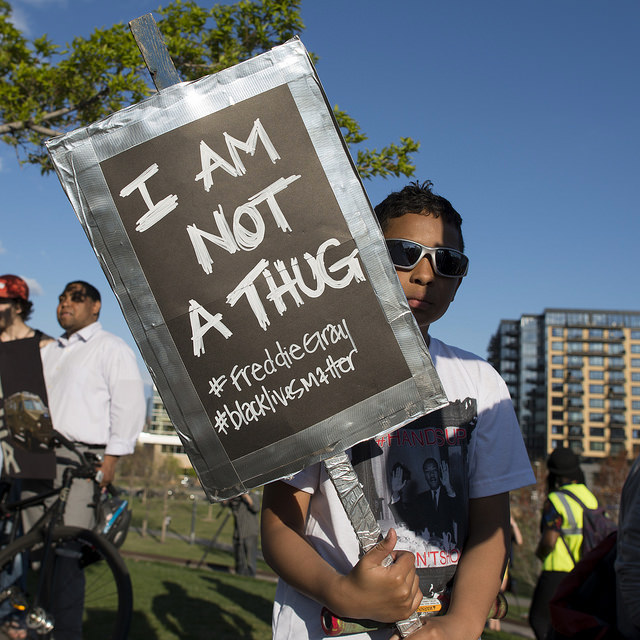By Jamye Wooten, thebtscenter.org
In July I was invited to speak about the #BaltimoreUprising at the Duke Summer Institute for Reconciliation. My presentation focused on “Why We Cry, How We Cry and Who Can Cry?” in response to state violence.
“Why We Cry” dealt with the systemic and structural violence in Baltimore City—the years of neglect, disinvestment and underdevelopment. “How We Cry (The Uprising)” addressed the community’s response to state violence and systemic and structural violence. And finally, “Who Can Cry?” raised the question of whether certain groups are allowed to express their pain publicly. Do blacks or the most marginalized in our society have the right to express frustration, anger, and outrage? Do they have the right, even, to be violent?”
These complex questions arise from a seemingly unending stream of difficult facts in America. From Trayvon Martin to Freddie Gray, the world has watched interactions between unarmed African Americans and law enforcement end in the death of black bodies. In a study entitled “Operation Ghetto Storm,” the Malcolm X Grassroots Movement found that at least 313 African Americans were killed by police, security guards, and self-appointed vigilantes in 2012. The group’s research found that one black person was killed in an extrajudicial shooting every 28 hours.
The Counted, a project by the Guardian newspaper documenting the number of people killed by police and other law enforcement agencies in the United States, has shown that as of November 1, 2015, some 957 people have been killed by the police in the United States. This past June, the Guardian published an article entitled “Black Americans killed by police are twice as likely to be unarmed as white people.” According to the piece, “32% of black people killed by police in 2015 were unarmed, as were 25% of Hispanic and Latino people, compared with 15% of white people killed.”
In response to these brutal facts, the national media in the United States have concentrated on How We Cry—on the anguish of African American family members, friends, and communities in the aftermath of wave upon wave of violence. But the Rev. Heber Brown, III, co-founder of Baltimore United for Change, has reminded us to “Be wary of those who are more concerned with the expression of your pain than the condition of your suffering.” To wit, one recent video by Brave New Films points to media bias between white rioters and black protesters, illustrating the ways in which blacks are often portrayed as violent.
After the death of Freddie Gray at the hands of Baltimore City Police, I joined with other grassroots activists in Baltimore to form Baltimore United for Change (#BmoreUnited), a coalition made up of social action groups, faith-based organizations, and concerned citizens working for justice in Baltimore City. We organized peaceful protests and held numerous nonviolent civil disobedience trainings for the community.
But even peaceful protests by African Americans can be viewed negatively by whites.
“Most white Americans generally believe that protests are good for the country, but they hold significant reservations about protests led by African Americans,” explained Dr. Robert P. Jones, CEO of Public Religion Research Institute (PRRI). In a recent survey, PRRI found that “two-thirds (67%) of white Americans agree that Americans protesting government mistreatment always leave the country better off. But fewer than half (48%) of whites say the same when asked about black Americans speaking out against and protesting unfair treatment by the government.”
 And whites aren’t alone in this perspective. In a press conference about the Baltimore Uprisings, President Obama referred to “looters” as “thugs and criminals.” Though he addressed some of the systemic and structural issues that plague Baltimore, he also said that there was no excuse for the violence. Afterward, local leaders—particularly clergy—were bombarded with questions and asked to condemn the broken windows and looting.
And whites aren’t alone in this perspective. In a press conference about the Baltimore Uprisings, President Obama referred to “looters” as “thugs and criminals.” Though he addressed some of the systemic and structural issues that plague Baltimore, he also said that there was no excuse for the violence. Afterward, local leaders—particularly clergy—were bombarded with questions and asked to condemn the broken windows and looting.
I find it particularly curious that whenever the state is violent toward the Black community, and the community mobilizes in response to that violence, the media begin to focus upon individuals I call “Preacher Pacifiers.” So often, members of the clergy who have been the most silent concerning state violence are tasked with bringing calm and peace to their communities–with restoring things back to “normal.”
Unfortunately, in some instances, these Preacher Pacifiers “treat the wound of my people carelessly, saying, ‘Peace, peace,’ when there is no peace” (Jeremiah 6:14). They ask for peace without addressing the root causes of its disruption. For that reason, The Rev. Dr. Martin Luther King, Jr. took on Preacher Pacifiers in a 1968 speech (“The Other America”), when he insisted, “It is not enough for me to stand before you tonight and condemn riots. It would be morally irresponsible for me to do that without, at the same time, condemning the contingent, intolerable conditions that exist in our society.”
Read Full Article on Bearings
